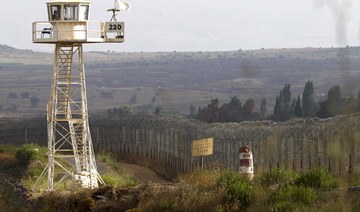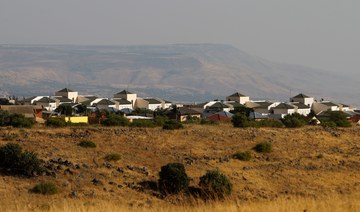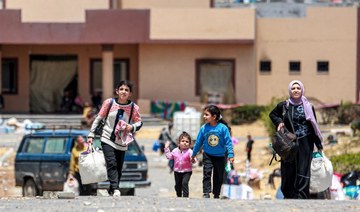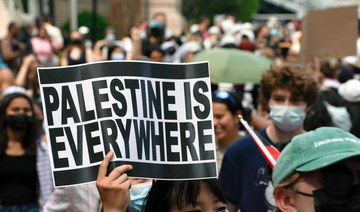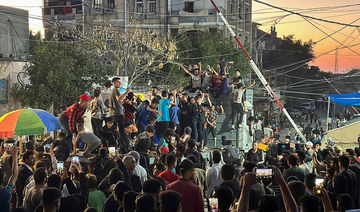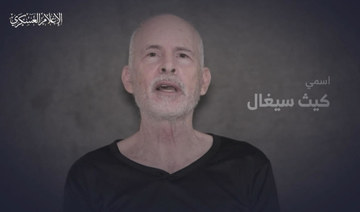BAGHDAD: US President Donald Trump’s statement recognizing Israel’s sovereignty over the Golan Heights “contravenes international law,” the Iraqi Foreign Ministry said on Twitter on Saturday.
Trump’s statement on Thursday marked a dramatic shift in US policy over the status of a disputed area that Israel captured from Syria in the 1967 Middle East conflict and annexed in 1981 — a move not recognized internationally.
The Syrian regime on Friday asked the UN Security Council to uphold resolutions declaring that Israel withdraw from the Golan Heights.
The regime’s Ambassador Bashar Jaafari urged the council to “take practical measures to ensure that the council is fulfilling ... its mandate in the implementation of its resolutions” concerning the Golan, in a letter seen by AFP.
The council is scheduled to discuss the Golan on Wednesday during a meeting on renewing the mandate of the UN peacekeeping force deployed between Israel and Syria in the Golan, known as UNDOF.
In the letter, the ambassador also asked Secretary-General Antonio Guterres to reaffirm the UN position on Israel’s occupation of the Golan, which it seized from Syria in the 1967 Six-Day War.
Asked about Trump’s stance, UN spokesman Farhan Haq said UN policy was based on council resolutions and those of the General Assembly on the status of the Golan.
“The resolutions are of course unchanged,” said Haq. “Our policies have not changed in that regard.”
The US backed Resolution 242 adopted in 1967, which calls on Israel to withdraw from territories it occupied in the Six-Day war and refers to the “inadmissibility of the acquisition of territory by war.”
The council adopted another resolution in 1973 that reaffirmed the demand for a withdrawal and in 1981, backed a separate measure that rejected Israel’s annexation of the Golan.
After Trump recognized Jerusalem as Israel’s capital, a group of Arab countries presented a resolution in 2017 condemning the decision to the General Assembly that won overwhelming support.
UN diplomats said it was premature to speculate as to whether there would be a similar measure in the assembly.
The US move — which came as Trump’s ally, Prime Minister Benjamin Netanyahu, faces elections — has caused dismay even among US allies, with France and Britain both saying that they still considered the Golan Heights to be “occupied” by Israel.
Richard Haass, president of the Council on Foreign Relations, feared the consequences of walking away from UN Security Council Resolution 242, which stressed the “inadmissibility of the acquisition of territory by war.”
“This is the most fundamental principle of international order and was the basis of US opposition to Saddam’s conquest of Kuwait and Putin’s of Crimea,” he said, referring to the 1991 Gulf War in which a US-led coalition freed Kuwait and Russia’s 2014 seizure of the Ukrainian peninsula.
Sweden’s former Foreign Minister Carl Bildt said that Trump was returning to the law of the “jungle.”
“This is a catastrophic departure from the very basis of international law. Kremlin will applaud and apply the same principle to Crimea. Beijing will applaud and apply to South China Sea,” Bildt tweeted.
France’s Foreign Ministry said in a statement that recognizing Israeli sovereignty “would be contrary to international law, in particular the obligation for states not to recognize an illegal situation.”
Steven Cook, an expert on the Middle East at the Council on Foreign Relations, in an article in Foreign Policy questioned the need to shake up the status quo, saying that US recognition only triggered fresh opposition to Israel’s longstanding control of the Golan, where 20,000 settlers live.
“In reality, there is no need for the recognition. Israel is in Golan for its own reasons, and nothing the Trump administration decides will change that,” he wrote.
Ilan Goldenberg of the Center for a New American Security said that Trump’s decision “stirs a hornet’s nest that didn’t need stirring.”
“Also, it makes it quite hard for the US to continue to contest Russia’s annexation of Crimea under the principle that taking territory by force is illegal. We now have no leg to stand on and the Russians will use it,” he tweeted.
“So why do it? Because this is awesome for Bibi’s politics,” he said, using Netanyahu’s nickname.
US call for Israeli sovereignty on Golan ‘contravenes international law’
US call for Israeli sovereignty on Golan ‘contravenes international law’
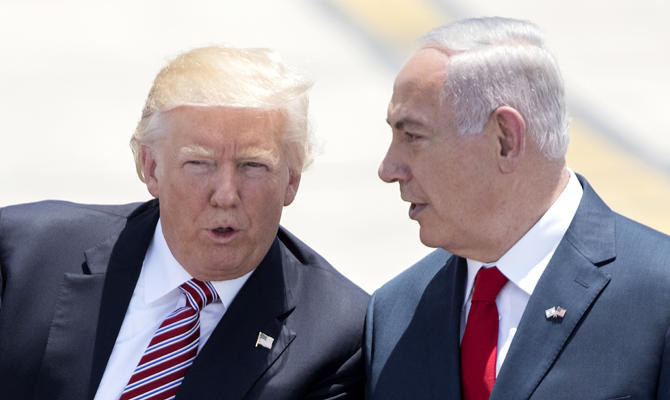
- France’s Foreign Ministry said in a statement that recognizing Israeli sovereignty would be contrary to international law, in particular the obligation for states not to recognize an illegal situation
Palestinian militants say they fired rockets from Gaza on Israel
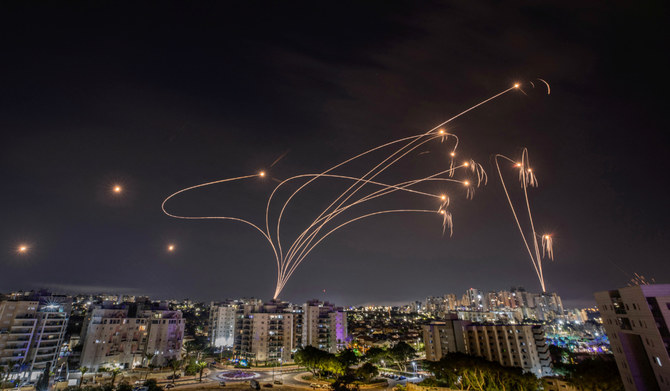
- The Israeli army said sirens sounded in communities near the Gaza Strip
- Israel has killed more than 34,600 Palestinians in Gaza, mostly women and children, according to the health ministry in the Hamas-run territory
GAZA CITY: The Palestinian Islamic Jihad’s armed wing said its militants had launched rockets from Gaza toward southern Israel on Monday in response to Israeli air strikes on the Palestinian territory.
“We have targeted Sderot, Nir Am, and settlements in the Gaza envelope with rocket barrages,” the Al-Quds Brigades said in a statement, referring to a zone of southern Israel close to Gaza.
The Israeli army said sirens sounded in communities near the Gaza Strip.
Erdogan opens former church to Muslim worshippers
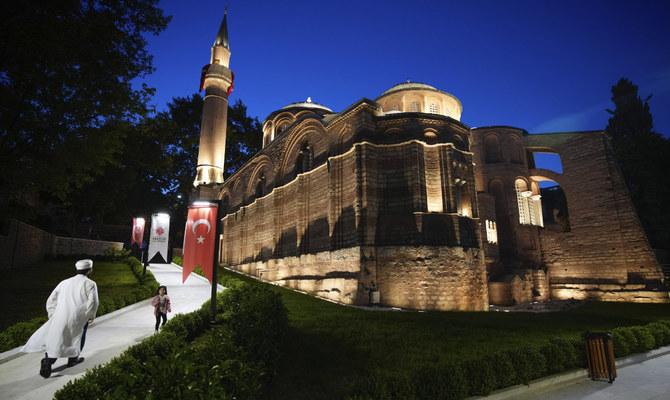
- Erdogan on Monday declared Kariye Mosque reopened for worship, remotely during a ceremony at the presidential palace in the capital, Ankara
ISTANBUL: Turkiye on Monday reopened a mosque converted from an ancient Orthodox church in Istanbul for Muslim worship, four years after the president ordered its transformation.
The Kariye Mosque was formerly a Byzantine church, then a mosque and then a museum.
President Recep Tayyip Erdogan, in 2020, ordered the building to be reconverted into a Muslim place of worship.
His order came followed a similarly controversial ruling on the UNESCO-protected Hagia Sophia — a cathedral in Istanbul that was converted into a mosque and then a museum, before becoming a mosque again.
The changes were seen as part of Erdogan’s efforts to galvanize his more conservative and nationalist supporters.
But they have also added to tensions with prelates in both the Orthodox and Catholic churches.
Erdogan on Monday declared Kariye Mosque reopened for worship, remotely during a ceremony at the presidential palace in the capital, Ankara.
An AFP picture from the mosque showed one worshipper wave a Turkish flag before the congregation who performed their prayers on a brick-red color carpet on Monday afternoon.
Images also revealed that two mosaics carved into the walls of the ancient church on the right and left sides of the prayer room were covered with curtains.
Most of the mosaics and frescos however remained visible to visitors.
“I had the opportunity to visit the place before and I was initially a little afraid of the work that could have been carried out,” said Michel, a French tourist, who would not give his full name.
“But ultimately we must recognize that it’s well done, that the frescos are accessible to everybody,” the 31-year-old researcher said.
Greece’s foreign affairs ministry on Monday night blasted a “provocation,” claiming that the move “alters the character” of the former church and “harms this UNESCO world heritage site that belongs to humanity.”
Neighbouring Greece had already reacted angrily to the decision in 2020 to convert the building.
The Holy Savior in Chora was a Byzantine church decorated with 14th-century frescoes of the Last Judgment that are still treasured by Christians.
The church was converted into Kariye Mosque half a century after the 1453 conquest of Constantinople by the Ottoman Turks.
It became the Kariye Museum after World War II, when Turkiye sought to create a more secular republic from the ashes of the Ottoman Empire.
A group of art historians from the United States helped restore the original church’s mosaics and they were put on public display in 1958.
Hagia Sophia — once the seat of Eastern Christianity — was also converted into a mosque by the Ottomans.
Ataturk, the founder of modern Turkiye after World War I, turned the UNESCO World Heritage site into a museum in a bid to promote religious neutrality.
Nearly 100 years later, Erdogan, whose ruling AKP party has Islamist roots, turned it back into a Muslim place of worship.
“It’s timeless, it’s something that for me is superior to Hagia Sophia,” Michel said of Kariye Mosque.
“It’s better preserved, less touristic and more intimate.”
Jordan’s King Abdullah presses Biden to avert Israel offensive in Rafah
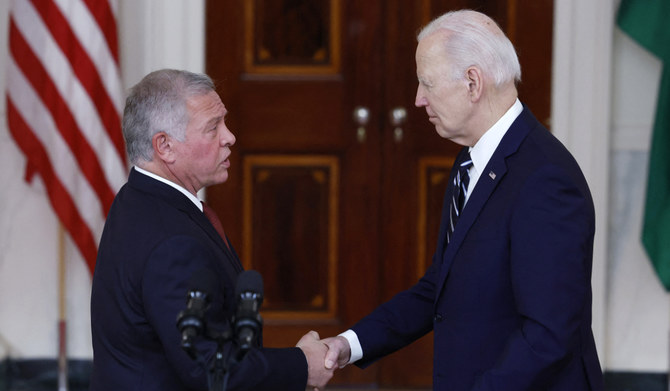
- Israel has killed more than 34,000 Palestinians, according to Gaza’s Health Ministry
- The Biden administration and Israeli officials remain at odds over Israel’s planned military incursion in the southern Gaza city of Rafah where it told Palestinians to start evacuating some parts on Monday
WASHINGTON: Jordan’s King Abdullah told US President Joe Biden in a private meeting on Monday that an Israeli offensive in Rafah would lead to a “new massacre” of Palestinian civilians and urged the international community to take urgent action.
“The king warned of the repercussions of the Israeli ground offensive on Rafah, which could cause a regional spillover of the conflict,” a statement from the Jordan royal court said after Abdullah had lunch with Biden at the White House.
Israel carried out airstrikes in Rafah on Monday and told Palestinians to evacuate parts of the city where more than a million people uprooted by the seven-month war are crowded together.
On Sunday, Hamas reiterated its demand for an end to the war in exchange for the freeing of hostages, and Israeli Prime Minister Benjamin Netanyahu flatly ruled that out. Hamas also attacked the Kerem Shalom crossing into Gaza, which Israel said killed three of its soldiers.
In a phone call on Monday with Israeli Prime Minister Benjmain Netanyahu, Biden pressed Netanyahu not to go ahead with a large-scale Israeli military offensive in Rafah. The US president has been vocal in his demand that Israel not undertake a ground offensive in Rafah without a plan to protect Palestinian civilians.
The Jordanian statement said Abdullah in his meeting with Biden “warned that the Israeli attack on Rafah, where 1.4 million Palestinians are internally displaced as a result of the war on Gaza, threatens to lead to a new massacre.”
“His Majesty stressed the importance of all efforts that seek an immediate ceasefire in Gaza,” it said. “The king and the US president affirmed their commitment to working to reach a sustainable ceasefire in Gaza, stressing the importance of facilitating the delivery of sustainable humanitarian aid to the Strip in light of the dire needs.”
The Biden administration and Israeli officials remain at odds over Israel’s planned military incursion in the southern Gaza city of Rafah where it told Palestinians to start evacuating some parts on Monday.
Biden last met King Abdullah at the White House in February and the two longtime allies discussed a daunting list of challenges, including the looming Israeli ground offensive in southern Gaza and suffering of Palestinian civilians. Jordan and other Arab states have been highly critical of Israel’s actions and have been demanding a ceasefire since mid-October as civilian casualties began to skyrocket.
The war began after Hamas stunned Israel with a cross-border raid on Oct. 7 in which 1,200 people were killed and 252 hostages taken, according to Israeli tallies.
More than 34,600 Palestinians have been killed and more than 77,000 wounded in Israel’s assault, according to Gaza’s health ministry.
What’s in the three-phase ceasefire deal Hamas backs, but Israel does not?
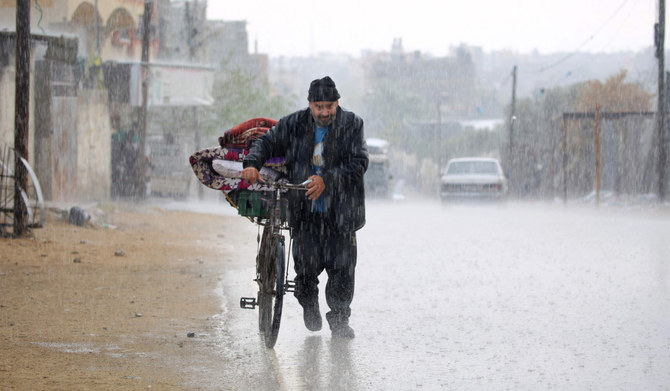
- Israel has killed more than 34,000 Palestinians, according to Gaza’s Health Ministry
CAIRO: Palestinian Islamist group Hamas said on Monday it had agreed to a three-phased deal for a ceasefire and hostages-for-prisoners swap, although an Israeli official said the deal was not acceptable to Israel because terms had been “softened.”
The United States, which alongside Qatar and Egypt has played a mediation role in the talks, said it was studying the Hamas response and would discuss it with Middle East allies.
Based on details announced so far by Hamas officials and an official briefed on the talks, the deal that the Palestinian group said it had agreed to included the following:
PHASE ONE
• 42-day ceasefire period
• Hamas releases 33 Israeli hostages in return for Israel releasing Palestinians from Israeli jails.
• Israel partially withdraws troops from Gaza and allows free movement of Palestinians from south to north Gaza.
PHASE TWO
• Another 42-day period that features an agreement to restore a “sustainable calm” to Gaza, language that an official briefed on the talks said Hamas and Israel had agreed in order to take discussion of a “permanent ceasefire” off the table.
• The complete withdrawal of most Israeli troops from Gaza.
• Hamas releases Israeli reservists and some soldiers in return for Israel releasing Palestinians from jail.
PHASE THREE
• The completion of exchanging bodies and starting the implementation of reconstruction according to the plan overseen by Qatar, Egypt and the United Nations.
• Ending the complete blockade on the Gaza Strip.
Ex-Gaza hostages in Auschwitz for March of the Living
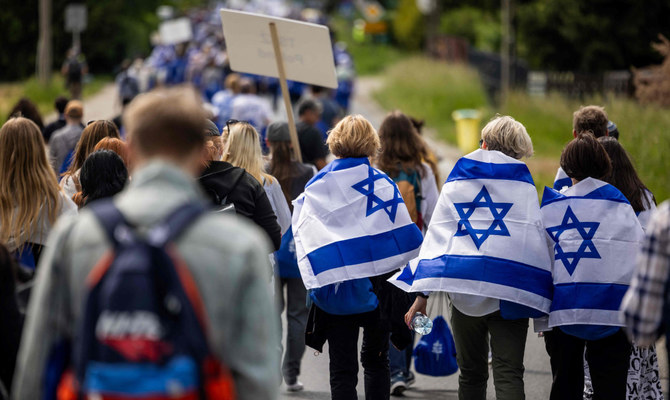
- One million European Jews died at the camp between 1940 and 1945 along with around 80,000 non-Jewish Poles, 25,000 Roma and 20,000 Soviet soldiers
OSWIECIM, Poland: Released Gaza hostages joined Holocaust survivors on Monday for an annual march in southern Poland to commemorate victims of the Auschwitz-Birkenau death camp.
Survivors of the October 7 attack on Israel by Hamas also joined the “March of the Living” at the site, which has become a symbol of Nazi Germany’s genocide of European Jews.
“I came to show that we’re alive and that we’ve built a country,” Bella Haim, 86, told AFP.
Her grandson Yotam Haim was captured by Hamas militants on October 7 and later gunned down in Gaza by Israeli soldiers who failed to realize he had escaped from his captors.
“I told myself that I couldn’t remain silent and I’m marching here in the name of my grandson Yotam and the victims” of the attack, Bella said.
She was part of an Israeli delegation that flew to Poland for the march in the southern city of Oswiecim, which numbered around 8,000 people this year.
Every year, Jews and non-Jews from around the world take part in the event at the site of the former death camp, which was built by Nazi Germany after it invaded Poland.
One million European Jews died at the camp between 1940 and 1945 along with around 80,000 non-Jewish Poles, 25,000 Roma and 20,000 Soviet soldiers.
The camp was liberated by the Red Army in January 1945.
This year’s March of the Living was briefly disrupted by pro-Palestinian protesters who spoke out against what they called Israel’s “genocide” in Gaza.
The war in Gaza broke out after Hamas’s unprecedented October 7 attack on Israel, which resulted in the deaths of more than 1,170 people, mostly civilians, according to an AFP tally of Israeli figures.
The militants also took some 250 hostages, of whom Israel estimates 128 remain in Gaza. The army says 35 of them are dead.
Vowing to destroy Hamas, Israel’s retaliatory offensive has killed at least 34,735 people in Gaza, mostly women and children, according to the Hamas-run territory’s health ministry.



